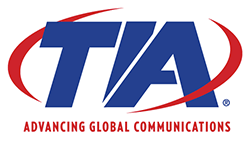Featured Partner: TIA
SBB is made possible by the contributions, support, and active participation of its Partner organizations.
The Telecommunications Industry Association (TIA) has been an SBB Partner since 2011.

Scope
The Telecommunications Industry Association (TIA) is the leading trade association representing the global Information and Communications Technology (ICT) industry through standards development, policy initiatives, business opportunities, market intelligence and networking events. With support from hundreds of members, TIA enhances the business environment for this industry.
TIA member companies and other participants contribute to established, evolving and new standards related to mobile, personal and emergency private radio; structural standards for communication and small wind turbine support towers and structures; multi-media access, protocols, interfaces; satellite equipment and systems; performance and accessibility for communications products; telecommunications cabling systems; mobile and point-to-point communications standards; terrestrial mobile multimedia multicast; vehicular telematics; healthcare telematics; machine-to-machine (M2M) smart device communications; smart utility networks; fuel cells for telecommunications; and ICT sustainability initiatives. Recent initiatives have included Connected Car, and 5th Generation (5G) Wireless.
Standard/Conformance Tools
The TIA-222-G, Structural Standard for Antenna Supporting Structures and Antennas, standard has become the most referenced document for cell phone towers and antenna structures. It has enabled government agencies, manufacturers, installers and engineering firms to design, construct and verify the structures needed to enable the expansive growth of the world’s wireless telephone industry.
The ANSI/TIA-942-A, Telecommunications Infrastructure Standards for Data Centers, standard has been adopted for use in countries around the world to enable a consistent approach to the design, construction, equipment, deployment, expansion, evaluation and operation of data center networks. This Standard has been instrumental in the growth of cloud services, and in empowering an efficient, cost-effective, competitive market place for the connected generation of network devices and applications.
Industry Sectors Served
Telecommunications, building/construction and infrastructure
Contact
Telecommunications Industry Association (TIA)
1320 N. Courthouse Road, Suite 200
Arlington, VA 22201
Web: www.tiaonline.org
E-mail: standards@tiaonline.org
Phone: 703.907.7700
Fax: 703.907.7727